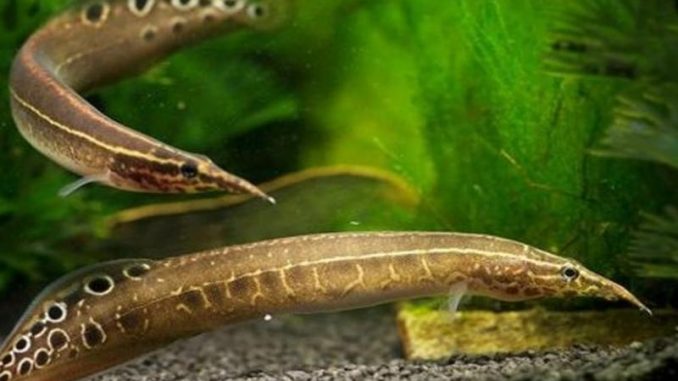
The peacock eel is a freshwater fish of the Mastacembelidae family. The species has a long, eel-like body in shades of brown, with eyespots decorating its tail and a yellow lateral stripe running from the fish’s snout to its caudal fin.
While peaceful, this species isn’t suitable for beginner aquarists because the fish are sensitive to water fluctuations and prone to infections.
TABLE OF CONTENTS
Peacock Eel Facts & Overview
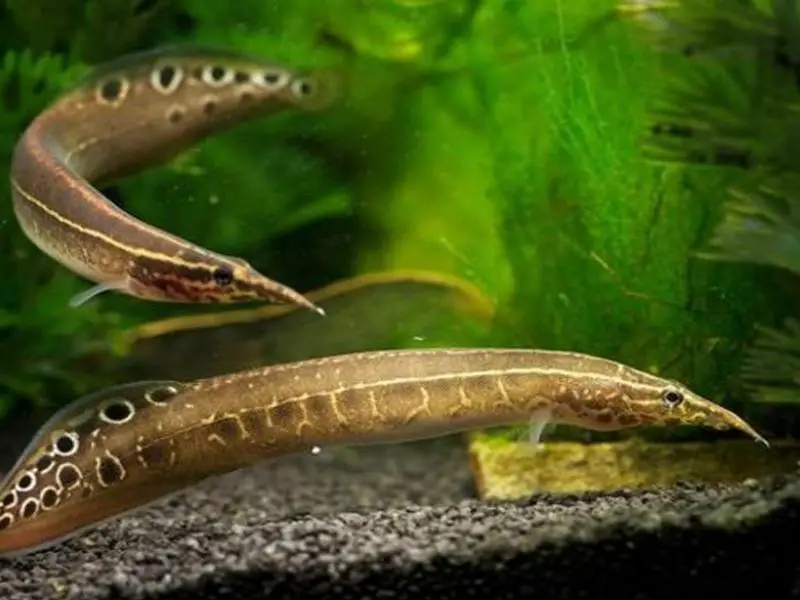
| Scientific name: | Macrognathus siamensis |
| Common names | Peacock eel, siamese spiny eel, spotfin spiny eel |
| Distribution: | Thailand, Cambodia, Laos, and Vietnam |
| Size: | Up to 12 inches |
| Life expectancy: | 8–18 years |
| Color: | Brown with eyespots and a yellow stripe |
| Diet: | Carnivore |
| Temperament: | Peaceful |
| Minimum tank size: | 35 gallons |
| Temperature: | 73–82°F (22–28°C) |
| pH: | 6–7 |
| Hardness: | 6–25 dGH |
| Care level: | Intermediate |
| Breeding: | Egg layers |
Origin
Peacock eels (Macrognathus siamensis) are native to Thailand, Cambodia, Laos, and Vietnam. They’re commonly found in the slow-moving backwaters of the Mekong and Chao Praya basins. Peacock eels thrive in bodies of water that are sandy, warm, and heavily vegetated. These fish are prolific in the wild but uncommon in the pet trade.
The peacock eel isn’t a freshwater eel. While the fish looks similar to a genuine eel, the peacock eel belongs to a different scientific order than the eel and has separated fins and spiny rays, in contrast to the eel’s soft-rayed fins.
Adult Size & Lifespan
Peacock eels reach 8 to 12 inches in length, and males and females are similar in size. The captive fish tend to be smaller than wild species.
These fish have an average life expectancy of 8 to 18 years if cared for properly. Stress, illness, and poor tank conditions can shorten the fish’s lifespan.
Availability
Peacock eels aren’t often stocked in aquarium stores, likely due to a lack of demand and because virtually all peacock eels in the pet trade are wild-caught. An individual peacock eel costs between $15 and $30, and the price depends on the fish’s age, size, and appearance.
While uncommon, peacock eels are available in online fish stores such as:
Appearance & Behavior
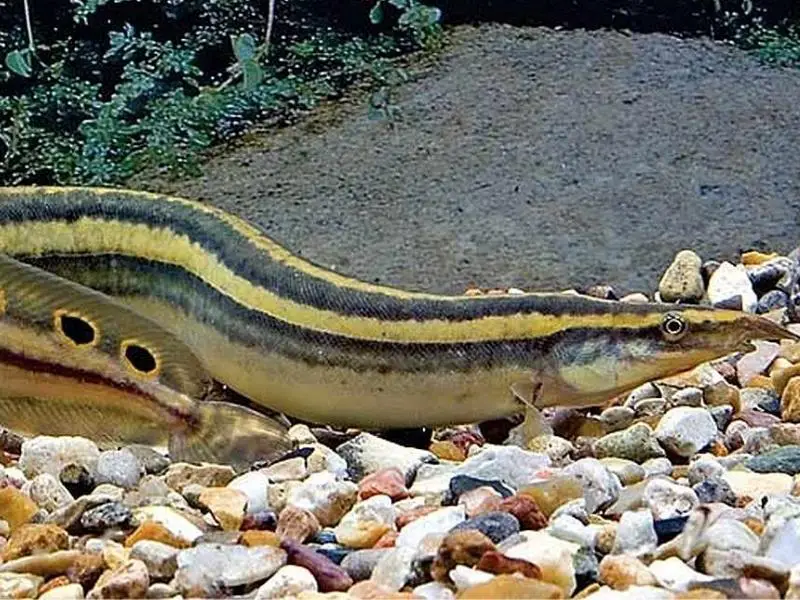
The freshwater peacock eel gets its name from its eel-shaped body and distinctive eyespots. The fish is shy, peaceful, and keeps to itself.
Colors, Patterns, Fins, and Sex Differences
The peacock eel has an elongated body, pointed snout, and compressed tail. The fish’s most distinctive features are several eyespots near the base of its tail. A pale yellow stripe also spreads from the fish’s mouth to its caudal fin. The anal, dorsal, and caudal fins are separated.
These fish have brown bodies and yellow bellies. Unlike many other fish species, peacock eels don’t have prominent scales. The dorsal fin has small, sharp spines.
Sexing this species, especially before maturity, is difficult, though female peacock eels are typically plumper than males. When stressed, the fish often lose their vibrant coloration and become lethargic. Symptoms of sickness include white blotches, red blisters, and tattered fins.
Typical Behavior
The peacock eel is a nocturnal species and spends most of its time burrowed in soft sand or silt. Despite its carnivorous nature, the fish is peaceful, shy, and keeps to itself.
These fish get along well with their own kind, as long as the tank isn’t overcrowded. Dim lighting, floating plants, and hiding spots help these fish feel safe and secure. The fish often uproot plants and decorations by their habitual burrowing.
Peacock Eel Tank Requirements
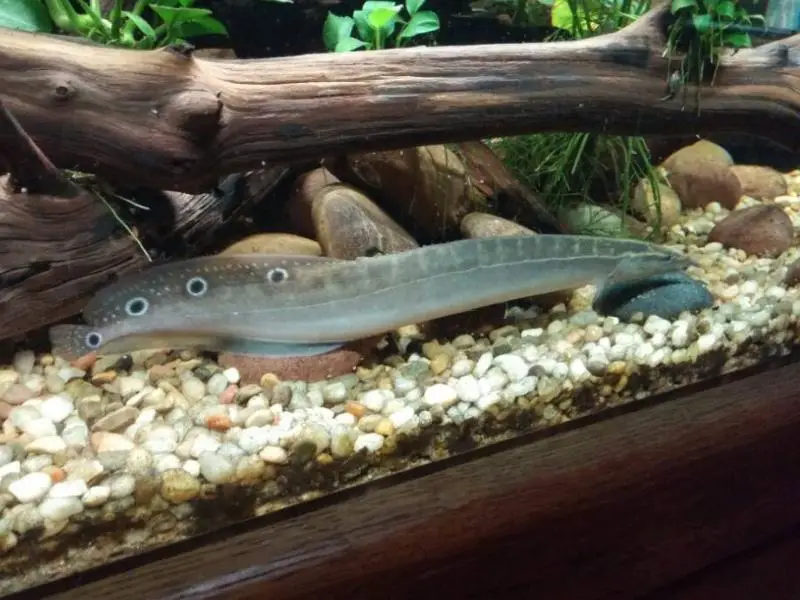
Peacock eels are moderately difficult to look after because they’re sensitive to water fluctuations, have specific tank needs, and are prone to infections. Replicating this species’ natural habitat helps the fish feel comfortable and secure.
Habitat and Tank Setup
In the wild, peacock eels inhabit rivers that are slow-moving, densely vegetated, and sheltered from the sun. To simulate these conditions in your own tank, add floating plants, a gentle filter, and keep the lighting dim. A freshwater eel aquarium should also have plenty of hiding spots.
Ensure the substrate in the fish’s tank is a few inches deep to accommodate its burrowing behavior. Avoid abrasive, harsh materials like gravel to protect the fish’s delicate body from injury.
Peacock eels often uproot plants and decorations. Tie decorations and plants securely or bury them firmly in the substrate to prevent the fish from dislodging them.
Tank Conditions
| Water type | Fresh water, with partial water changes (30%) every week to maintain water quality. Monitor water parameters regularly with a pH meter and thermometer |
| Tank size | 35 gallons minimum, elongated shape |
| Water temperature | 73–82°F (22–28°C) |
| Substrate | Fine, soft sand |
| Tank setup | Floating plants and plenty of hiding spots. Create shelter with decorations, foliage, PVC pipes, and bogwood |
| Acidity | 6.0–7.0 pH |
| Water hardness | 6–25 dGH |
| Filter | Gentle, avoid under-gravel filters |
| Lighting | Provide 8 to 12 hours of low light per day |
Peacock eels thrive in well-oxygenated, clean water, so frequent, partial water changes are vital to the fish’s health and wellbeing. Cycle the tank for at least two weeks before introducing fish to the tank.
Common Peacock Eel Health Issues and Diseases
Peacock eels have delicate bodies and are particularly susceptible to abrasions, parasites, and infections. The fish don’t tolerate medications well, particularly copper-based treatments, so focus on preventing health issues by reducing stressors and keeping the water clean and stable.
Health Issue | Symptoms | Suggested Action |
| Abrasions | Lesions on the fish’s body, lethargy | Keep water clean and at ideal parameters to prevent sores from becoming infected. Ensure the substrate is fine and soft and remove rough decorations |
| ICH | White, salt-like spots, scraping body against rough surfaces | Quarantine infected fish in a separate tank and gradually raise the temperature by a few degrees to kill off the parasite |
| Fin rot | Discoloration, ragged fins, tattered appearance | Antibiotics or antifungal medication, though avoid copper-based medications |
Peacock Eel Tank Mates
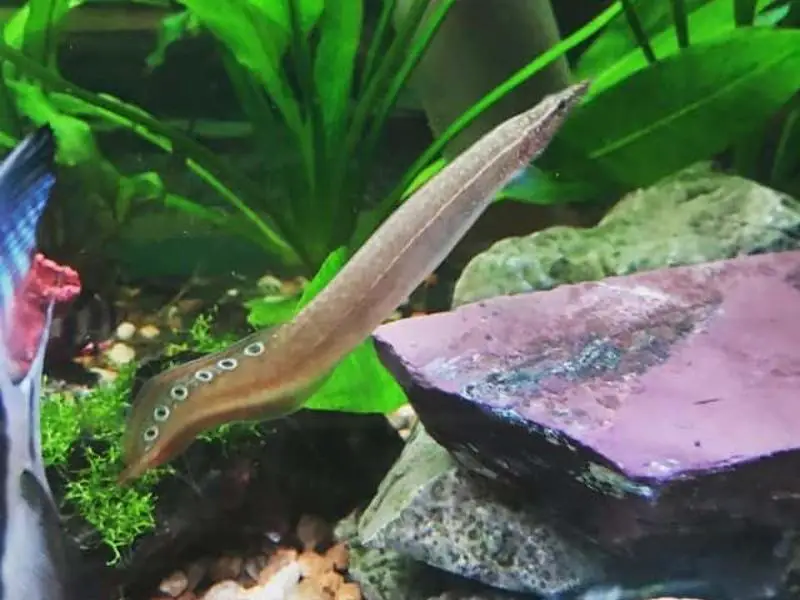
Peacock eels are docile, shy, and make excellent additions to community aquariums. Tank mates should be peaceful, slow-moving, and similar in size to peacock eels.
Great tank mates for peacock eels include:
- Hatchetfish
- Rainbowfish
- Swordtail fish
- Large gouramis
- Guppies
Never keep the peacock eel with boisterous, aggressive species, or small species that the carnivorous peacock eel might eat.
Peacock Eel Diet and Feeding
Peacock eels are carnivores that exhibit foraging behavior and feed at night. In the wild, their diet mainly consists of crustaceans, larvae, and worms. Captive peacock eels should be fed protein-rich, live and frozen foods such as bloodworms, daphnia, and brine shrimp. These fish rarely accept pellets or flakes.
Feed peacock eels at night and offer food two to three times per week. Food must be smaller than the fish’s mouth.
Breeding the Freshwater Peacock Eel
Peacock eels are egg layers. While prolific in the wild, breeding these fish in captivity is virtually impossible — peacock eels spawn in the flood season, an environment that is difficult to simulate in a home tank. Fry are also challenging to raise because they’re prone to infections.
Should You Get a Peacock Eel for Your Aquarium?
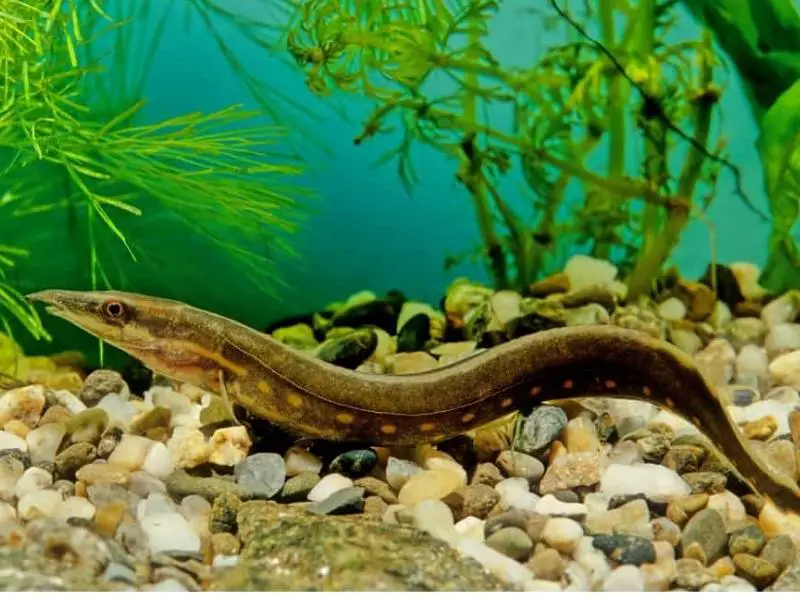
The peacock eel is a fantastic freshwater eel to keep in a fish tank because the species is peaceful, unique, and doesn’t disturb other species.
You should get a peacock eel if you own a 35-gallon tank that contains hiding spots, dense vegetation, and a soft, sand substrate. This species isn’t suitable for beginner fishkeepers because the fish are susceptible to infections and are easily stressed if water parameters aren’t ideal.
Although peacock eels require more care than other species, fishkeepers up for the challenge will be blessed with a long-living, captivating companion.
Peacock Eel FAQs
Here are the answers to the most frequently asked questions about peacock eels:
How Big Do Peacock Eels Get?
Peacock eels grow up to 12 inches long. However, most fish only reach 8 inches in captivity. Males and females are similar in size, though females tend to be plumper than males.
An overcrowded tank can cause stunted growth in the peacock eel. Other factors that can affect the fish’s size include age, diet, and water conditions.
What Fish Can Live With Peacock Eels?
Peacock eels can live with most peaceful fish species. Suitable tank mates include hatchetfish, gouramis, rainbowfish, and guppies.
These fish often eat small fish and invertebrates, so ensure all tank mates are similar in size to the peacock eel.
While carnivorous, peacock eels are docile and shy, and shouldn’t be housed with aggressive species.
What Size Tank Do Peacock Eels Need?
Peacock eels need a tank of at least 35 gallons. Increase the tank size by 25 gallons for every additional fish. Large fish that measure over 10 inches in length should be housed in a 40-gallon tank or bigger.
The peacock eel’s tank should be wider than it is tall because peacock eels are bottom-dwellers and need more bottom terrain to explore. Add floating plants, hiding spots, and foliage, but don’t overcrowd the tank.
Can You Keep Peacock Eels Together?
Yes, you can keep peacock eels together. These fish aren’t as territorial as other spiny eel species. A cramped, overcrowded space can make peacock eels aggressive with one another. Make sure your group of peacock eels have a tank that is spacious, densely vegetated, and that there are plenty of hiding spots for the fish to take refuge in.
How Often Do You Feed Peacock Eels?
Feed peacock eels two to three times per week. Because this species is nocturnal, the fish should be fed during the evening or early morning. Feed these fish live and frozen foods such as brine shrimp, daphnia, and bloodworms. Some peacock eels may reject food offerings and eat less frequently. Fish that refuse food entirely, or have a noticeable change in appetite, are potentially sick or stressed.

Be the first to comment